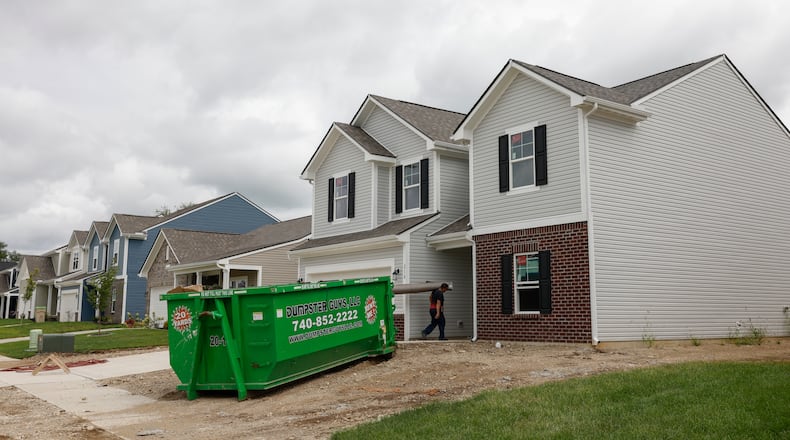Ohioans have been hard hit by tax increases over the last several years and many are advocating for major reforms.
The state legislature has proposed several bills aimed at property tax reform, including one that would abolish the tax all together.
Ohio Gov. Mike DeWine recently vetoed three property tax reform efforts, with the state legislature overturning one and expected to do the same for the others.
What impact will taxpayers see next year?
While property owners should plan for tax increases next year, Hamilton said it’s hard to pin down specifics.
“Let’s say you were one of the average people that your property value went up 32%; it does not mean your taxes will go up by that same percentage either,” Hamilton said. “That is truly just your value; it is not a one-to-one relationship.”
After the November election, the auditor’s office will submit tax rates to the state, which will then evaluate growth and new value increase to come up with a reduction factor to keep taxes “fair and equitable,” Hamilton said.
“Your taxes do not go up that 32% if we raise your value 32%,” Hamilton said. “The goal is to keep it down. It’s not supposed to go up that much.”
The auditor’s office is finishing the six-year appraisal process mandated by Ohio law. Every three years, the appraisal is updated.
The appraisal process includes aerial and street-level imagery as well as “boots-on-the-ground,” where appraisers are out in the field to look at every single property’s exterior, Hamilton said. Every property owner will receive a mailed notice with a tentative value for 2025 within the next few months.
If a property owner feels their tentative value is inaccurate, they can take part in an informal hearing to receive an explanation and provide information like sales or recent appraisal data, Hamilton said. The auditor’s office can change the value but only has an about two month window before final valuations go to the Ohio Department of Taxation at the end of October.
In December, the auditor’s office will get new tax rates for next year.
Property taxes can be estimated with the auditor’s office’s online tax estimator tool, Hamilton said. Once property owners get notification of their reappraised value, the tool can be useful in estimations, though Hamilton said it’s important not to use it for very specific budgeting, as it does not yet take into account any new taxes following the election.
Property values interact with taxes through millage rates, of which there are three kinds, Hamilton said:
- Inside millage, which allows 10 mills of property tax to be applied automatically without a vote, with mills increasing as property value does,
- Voted millage, which are levies that are voted upon to fund public infrastructure like schools, townships and libraries; these levies cannot increase with inflation; and,
- The 20-mill floor, which only applies to your school district’s current expense levy; if a rising property value pushes the rate below that levy, Ohio law requires it be returned to 20 mills to prevent the school from losing funds, which can result in a tax increase.
What tax increases could Clark County residents see?
Several tax bumps will be on the ballot this November, including a countywide 0.6-mill replacement levy for parks and recreation and a 20-year, 0.5% sales and use tax to fund a new jail. Three schools are asking for additional or substitute property or income taxes as well.
If the 0.6-mill replacement levy for parks and recreation passes, property owners are estimated to pay $21 per every $100,000 of property value to generate $1,942,000 in total.
If the 0.5% sales tax passes, Clark County shoppers should expect increases on all taxable items like Tide detergent and vehicles — estimated to see seven-cent and $200 increases, respectively.
Clark County’s current sales tax is 7.25%, which includes the state sales tax of 5.75% and the county sales tax of 1.5%. This ballot measure would increase the sales tax to 7.75%.
Property tax needs reformed, say County Auditors’ Association, legislators
Property taxes need major reform, Ohio Sen. Kyle Koehler, R-Springfield, said. He, like many others in the statehouse, believes property tax should be abolished.
However, until a viable funding source for schools, fire departments, the roads, park districts and organizations like United Senior Services can be found, Koehler said it’s not realistic to eliminate the tax yet.
The state collects $19.5 billion in property taxes to then be used for public essential services, Koehler said, and there is no easy alternative source. Property taxes are the most effective way to generate guaranteed funds “because it comes with the heavy-handed ability to take away someone’s home if they don’t pay the taxes,” he said.
Everyone is affected by property taxes and property value increases, Koehler said. As taxes increases, often rent does, too.
“When you vote on that levy or for the new parks district levy or United Senior Services or for the library, you don’t realize you’re raising your rent,” Koehler said. “I think a lot of people don’t know because you don’t directly see that.”
Credit: Jessica Orozco
Credit: Jessica Orozco
DeWine put together a property tax working group to find a means for property tax relief that does not negatively effect local taxing jurisdictions’ funding. The group is tasked with giving recommendations by the end of September.
The bipartisan County Auditor’s Association of Ohio, of which Hamilton is a member, advocates for four reforms:
- Expand the Homestead program, which exempts taxes on the first $26,200 of property value for those 65 or older or who are permanently disabled and meet income requirements. The state pays those exemptions to the county and public services do not miss out on those funds. CAAO proposes increasing the tax-exempt property valuation and the income threshold to allow more people to qualify.
- Eliminate the non-business credit and expand the owner-occupancy credit. The state pays a portion of qualifying property taxes on behalf of residential and agricultural property owners, providing a 10% credit. The non-business credit gives a 10% credit to property owners with agricultural or residential properties and the owner-occupancy credit gives a 2.5% credit to properties owned and occupied as a primary residence. CAAO advocates for eliminating the non-business credit, which it says benefits for-profit owners, and expanding the owner-occupancy credit for “real tax relief to those homes that are owner-occupied.”
- Limit the growth in revenue received by school districts due to reappraisal changes. School levies have a floor that prevents the tax rate from going down when reappraisal increases happen. CCAO proposes eliminating the hard cap on reductions and limiting growth on some school levies to “an inflationary index, containing revenue growth for districts operating at the 20-mill floor.”
- Create a menu of targeted relief. CCAO advocates for tax relief programs for low- to moderate-income residents, like income tax credits, tax deferrals or abatements depending on “a long-term resident’s inability to pay the ever-increasing tax burden.”
With property values going up and taxes following suit, some Ohioans are being priced out of their homes.
“This has gotten out of hand as far as especially seniors who are on a fixed income [who] never expected to be paying mortgage rates on a home that they don’t actually have a mortgage [on],” Koehler said. “And there are people saying, ‘I have a choice. I can either stay in my home and pay the property taxes but not have enough for my medication and food and everything else,’ or they sell their home.”
Koehler pointed to a 92-year-old northwest Springfield resident who has lived in his home for at least 44 years. From 2010 to 2024, his property tax payments have gone from about $2,200 a year to $3,200 annually. He’s on a fixed income and gets a $500 annual Homestead exemption.
“It’s just wrong that still at 92 he’s having to pay probably more than he ever expected to pay on his mortgage for a $40,000 home,” Koehler said.
About the Author


